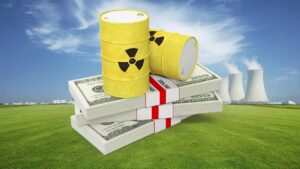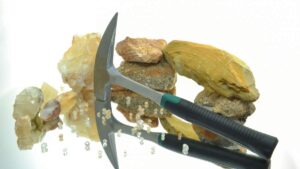Greenvale Energy outlines continuous uranium mineralisation at Oasis

Chemical assays have confirmed thick, high-grade uranium at the Oasis project in Queensland. Pic: Getty Images
- Greenvale’s latest chemical assays shows continuous high-grade uranium mineralisation at Oasis
- The geological host is confirmed as being the chlorite-biotite schist shear zone, confirming structural controls on the mineralisation
- The immediate plan is to now build geological models for the asset, which will be used to plan next drilling
Special Report: Chemical assay results from Greenvale Energy’s second drillhole at the Oasis uranium project has confirmed thick, high-grade uranium intercepts, with early indications suggesting mineralisation starts near surface and continues down dip.
It’s reinforced Greenvale’s (ASX:GRV) conviction in the quality and potential of the Queensland uranium project, which has been reborn decades after its initial discovery as the world runs short of uranium project to fuel a dramatic coming surge in demand.
Laboratory chemical analysis from diamond drill-hole 25GRV002 delivered 8m at 2125ppm U3O8 from 84m including 5m at 3263ppm U3O8 from 84m, matching up with earlier spectral gamma logs
Greenvale (ASX:GRV) says the mineralisation is structurally controlled and hosted in the same chlorite-biotite schist shear zone as that identified in the first drill-hole 25GRV001.
Geological observations from previous reconnaissance programs identified minor outcrops of the same, radiometrically anomalous granitic gneiss and chlorite-biotite schist along a north-south trend from the main mineralised area.
This provides strong indications that the mineralisation continues along strike, which will be followed up in future work programs planned for the next quarter.
Remaining assays to guide next phase of development
GRV CEO Alex Cheeseman said the second set of chemical assay results further reinforces confidence in the Oasis Project, with the strong correlation between spectral gamma logging results and the high-grade chemical assays representing an excellent outcome.
“With the maiden drill program now completed, we are looking forward to receiving the remaining assay results and data, which will provide vital inputs for the next stage of project development,” he said.
“Our immediate focus will be the development of a geological model with concurrent planning of a trenching program that will support the development of future drill targets.”
Background on Oasis
Historical exploration at Oasis, first by Esso in the 1970s and later by Glengarry and Mega Uranium, laid the groundwork and confirmed uranium mineralisation in the area.
Beyond the main deposit, early-stage work on regional radiometric targets has already returned promising rock chip results, with grades up to 187.4ppm uranium.
Oasis is now showing traits similar to Alaskite deposits, where uranium concentrates in shear zones linked to intrusives.
Greenvale believes the asset has strong potential to host a world-class Alaskite-style system, reminiscent of Namibia’s Rossing deposit.
Upcoming exploration plans
The Oasis drilling program has now been completed, with a total 1804.2m drilled across twelve holes.
Processing of the drill core is ongoing, with the collection of detailed, systematic, geological logging, geotechnical and structural measurements.
The immediate objective is to build comprehensive geological models for Oasis, which will be utilised to plan the next phase of drilling.
Assay results from the completed holes will be reported as they become available.
Concurrent planning for trench sampling across the northern and southern strike extensions of the deposit is ongoing, with work expected to begin in Q4.
This article was developed in collaboration with Greenvale Energy, a Stockhead advertiser at the time of publishing.
This article does not constitute financial product advice. You should consider obtaining independent advice before making any financial decisions.
Related Topics

UNLOCK INSIGHTS
Discover the untold stories of emerging ASX stocks.
Daily news and expert analysis, it's free to subscribe.
By proceeding, you confirm you understand that we handle personal information in accordance with our Privacy Policy.








